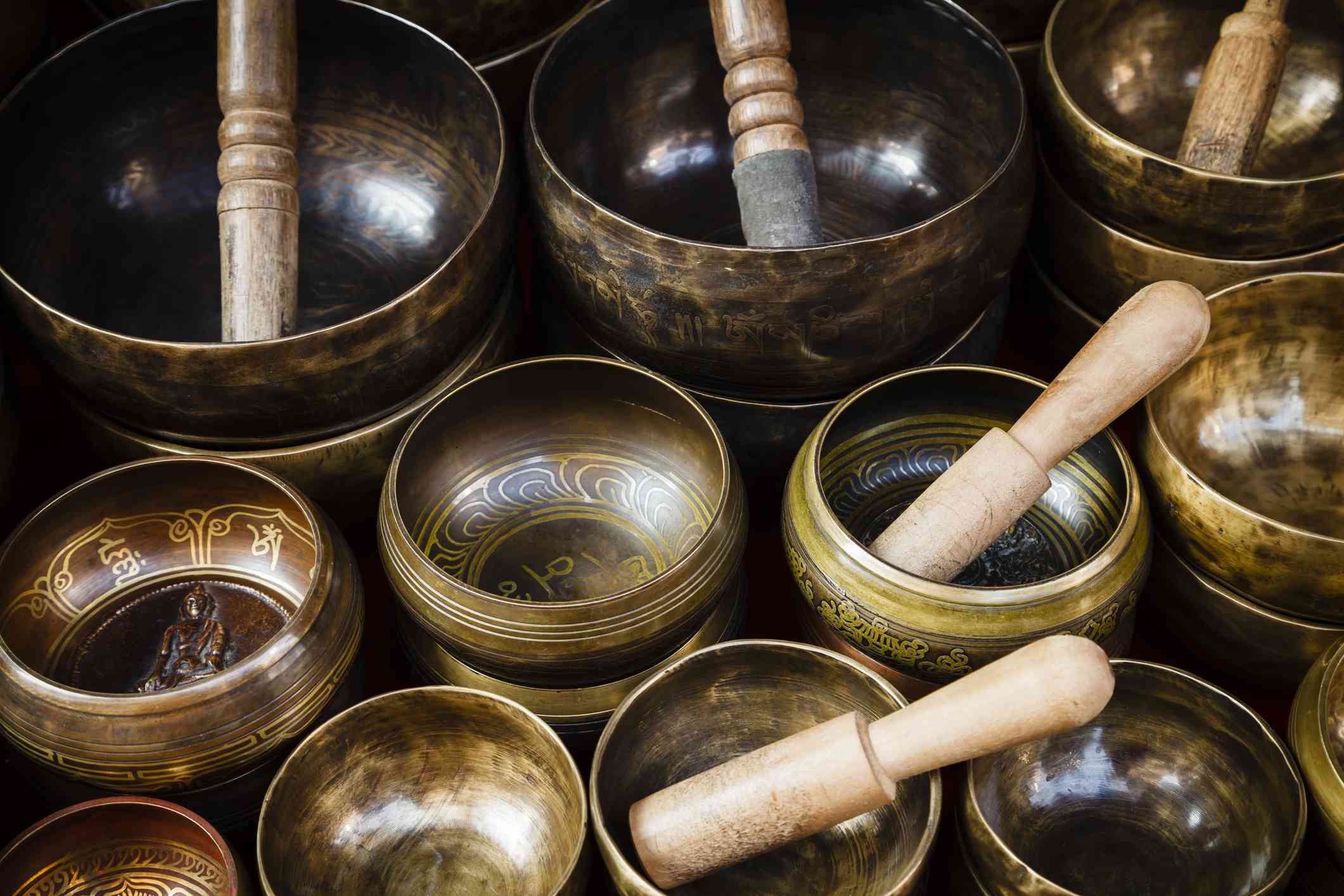Have you ever wondered how singing bowls work? In this post, we answer that question by discussing the science of singing bowls. Read on to learn how these incredible creations produced their incredible sounds. We also explain how singing bowls can be used with water to change their sounds as well as discuss the physical effects of playing singing bowls.
Introduction
While the enthralling sounds of singing bowls might calm you, they might also spark the question, “how exactly do they work?” Like all musical instruments, Tibetan singing bowls rely on friction and vibration to create the sound we hear. What makes singing bowls so special are the different sounds that can be created by them depending on their qualities and the various circumstances and conditions in which they may be played.
Scientists and musicians alike have recently become interested in the singing bowl and the manner in which it creates sound. The science behind the sounds of singing bowls is quite simple and can best be compared to playing wine glasses filled with water. However, the science behind the healing properties of singing bowls is not quite as familiar or established.
In this article we discuss:
-
How do singing bowls work?
-
How can singing bowls be used with water?
-
What are the physical effects of singing bowls?
How Do Singing Bowls Work?
To play a singing bowl, one must either strike the bowl or rub the rim with a mallet. The action taken with the mallet is the first step in creating sound with a singing bowl. As explained by Science Made Simple UK, the friction created either by rubbing or striking a singing bowl creates vibrations. These vibrations create the sound we hear and can feel when holding the singing bowl. As you continue to rub the rim of the bowl, the friction keeps the sound going. This is called resonance. Resonance is the note we hear even after the player ceases contact between the singing bowl and the mallet.
To make matters a bit more complicated, the note we hear can differ between singing bowls and mallets. Most singing bowls are made from a bronze alloy of either copper, tin, zinc, iron, silver, gold, or nickel. The material with which the singing bowl is made can change the sound, as can the mallet. Crystal bowls will not sound the same as bronze alloy bowls. Wooden mallets and padded mallets will produce different sounds as well. The size, shape and weight of the singing bowl can also affect what tones are produced. Adding water will change the note of the singing bowl as water is more difficult to vibrate than the air inside an empty singing bowl. Cushions, rings, or other accessories also alter the sound of singing bowls, often dampening or softening the sounds. Despite these differences, how singing bowls work can be boiled down to a simple idea: excitation of the rim causes the singing bowl to vibrate, creating a rich tone.
Singing Bowls and Water

Source: BBC
Source: BBC
Many of the studies revealing the inner workings of singing bowls focus on singing bowls filled with water. In particular, there are multiple studies devoted to observing the way water is excited when playing a singing bowl. Two studies, one done by Octávio Inácio et al. called “The Dynamics of Tibetan Singing Bowls,” and another by Denis Terwage and John Bush called “Tibetan Singing Bowls,” have studied just that. These groups observed singing bowls filled with water being played with slow motion video and sound recording. In turn, their studies were summarized in a BBC article by Jason Palmer.
They found that as the singing bowl is played, the rim begins to change shape, switching back and forth between slightly oval shapes. The energy of the bowl transfers to the water. The energy charged water creates waves, which create droplets of water that bounce and skip on the surface. This phenomenon is known as Faraday waves. These studies have much larger implications than just acoustic music or sound meditation and healing–the study of the singing bowl’s Faraday waves can actually be applied to processes such as fuel injection.

A figure from the study, “
A figure from the study, “ The Dynamics of Tibetan Singing Bowls ”, showing the different shapes of singing bowls when being played.
Adding water changes the frequency of the singing bowl. The addition of water often lowers and creates a deeper, longer-lasting resonance. Incorporating water filled singing bowls can create additional tones used for meditation or sound therapy, but it can also be an example of an interesting science experiment. How singing bowls work is based on scientific studies and physics. On the other hand, the effects of singing bowls on our bodies and well-being is on less solid scientific ground but should be discussed nonetheless.
What are the Physical Effects of Singing Bowls?
Researching the scientific physical effects of singing bowls has yielded lots of contradictory evidence. Overall, most publications focus on the beneficial side effects of using a singing bowl in sound therapy rather than scientific proven fact that singing bowls can heal a variety of ailments. In fact, Chris Kyriakakis, a professor of audio signal processing at the University of Southern California’s Viterbi School of Engineering has said that there are no “scientific published peer reviewed papers” that support the claims that sound therapy “unblocks or redirects energy in the body” or that the vibrations produced work in tandem with humans’ own vibrational frequencies.
Despite Professor Kyriakakis’s statements, positive testimonials from other professionals and practitioners is overwhelming. One of the biggest proponents of using singing bowls for healing was Mitchell Gaynor, an oncologist and professor at Weill Cornell Medical College. Gaynor, who began working with singing bowls in the 1990s, championed the use of sound healing in addition to conventional treatment and medicine. The reason for this, Gaynor argued, was that sound therapy eased the psychological and physical effects of those with disease. He also argued that sound therapy gave patients “lower stress hormones and stronger immune systems.” The pulsating tones of the singing bowl help practitioners feel good and relax.
Practitioners will also sometimes provide the afflicted with sound therapy as an alternative treatment for problems such as anxiety, chronic pain, sleep disorders, and PTSD. These practitioners maintain that sound therapy places listeners in a meditative state, in turn, allowing them to de-stress, relax, and heal.
There are numerous articles on the internet written by sound healers and those that incorporate singing bowls into their treatment for a variety of illnesses and disorders. Singing bowl vibrations can have various physical, emotional, and spiritual effects on the mind and body. Sound therapy can be a great additional or alternative treatment to a number of physical or mental problems or just added relaxation to meditation or yoga classes.

Source: Awakening Wellness Center
The Bottom Line
We now know that singing bowls sing not because of magic or mystical forces. Singing bowls sing because of physics! Vibrations and resonance are created by striking the bowl with a mallet. In addition, while the scientific evidence is not clear, a wealth of anecdotal evidence indicates that singing bowl tones have positive physical, mental, and emotional effects on those who hear them. Tibetan singing bowls have been used in religious practice for about 2500 years and are now increasingly found in sound therapy practices, meditation, and yoga classes. Singing bowls work like any other instrument but their implications to improve our lives are endless!
We invite you to get your own Tibetan singing bowl or crystal singing bowl today!
Did You Enjoy This Article?
Thank you for reading! If you enjoyed this article, you might also like the following articles: Singing Bowl Tones and Frequencies: Complete Guide and Crystal Singing Bowls: The Complete Guide
Relevant Products
Tibetan Singing Bowl
Crystal Singing Bowl
Singing Bowl Ring Cushion
A Tibetan singing bowl is a type of bowl that vibrates and produces a rich, deep tone when played. Also known as singing bowls or Himalayan bowls, Tibetan singing bowls are said to promote relaxation and offer powerful healing properties.
Buddhist monks have long used Tibetan singing bowls in meditation practice. In addition, some wellness practitioners (including music therapists, massage therapists, and yoga therapists) use Tibetan singing bowls during treatment.
This article discusses how Tibetan singing bowls are used and their purported benefits. It also covers what you should consider before you try using this type of treatment.
History of Tibetan Singing Bowls
There is debate about the exact origins of the Tibetan singing bowl, although there is some evidence that it may have originated in China sometime around the 16th century BC. Traditional bowls were made of a variety of metals including mercury, lead, silver, iron, gold, and copper.
During the 1970s, people began importing the bowls to North America and Europe. They grew in popularity in the 1990s as a complementary and alternative treatment for a variety of ailments.
Recap
Tibetan signing bowls have a history that dates back thousands of years, but they only became popular in the U.S. starting in the 1970s.
Uses for Tibetan Singing Bowls
Very few scientific studies have examined the potential benefits of Tibetan singing bowls, despite their long history of use. But some people do report that using the bowls help them feel more relaxed.
Uses for singing bowl therapy include:
- Stress relief: Some research supports the use of Tibetan singing bowls as a way to promote relaxation and reduce feelings of anxiety.
- Improving sleep: Because singing bowl therapy has been linked to decreased anxiety and tension, it may be helpful for improving sleep. Further research is needed to support this.
- Lowering blood pressure: A preliminary study published in the American Journal of Health Promotion in 2014 examined the benefits of starting a directed relaxation session with 12 minutes of singing bowl sounds. It found a greater reduction in systolic blood pressure and heart rate compared to silence before the session.
- Reducing depression: One study linked singing bowl therapy to improvements in mood and suggested that this approach may be a low-cost way to help reduce symptoms of depression.
- Stimulating the immune system: Some also claim that Tibetan singing bowls can stimulate the immune system and produce beneficial changes in brain waves.
- Pain relief: One study looking at chronic spinal pain found that people treated with singing bowl therapy experienced significantly decreased pain intensity as well as decreased stress. However, placebo treatment had the same effects, so the study’s authors concluded that singing bowl therapy’s effectiveness for pain relief could not be confirmed.
- Balancing and harmonizing the body: Many proponents claim that the vibrations of a singing bowl can produce beneficial changes in the body by “harmonizing” the cells and “balancing the body’s energy system.”
- Enhancing other healing practices: Some people use the bowls in combination with other healing practices, such as meditation and deep breathing.
Do Singing Bowls Work?
It is important to note that while Tibetan singing bowls are often used for these purposes, research is still needed to determine what impact they actually have. Proponents may suggest that they have these benefits, but that does not mean that they actually work. Some of the claims don’t have a clear scientific basis.
How to Use Tibetan Singing Bowls
During singing bowl treatment, you will lie on the floor while the bowls are placed in different configurations. For example, they might be placed around your body, on your body, or in different locations around the room.
Once positioned, the practitioner will use mallets to strike the bowls in a sequence in order to produce sounds and vibrations. In some cases, your practitioner may also include a guided meditation.
To use a singing bowl yourself, firmly press the accompanying mallet in a circular motion against the bowl’s outside edge or rim. When you hear a bright, clear tone, you can slow down the motion. Use your full arm to make the motion, rather than just rotating your wrist.
You can also make the same circular motion against the outside belly of the bowl. Additionally, you can gently strike the bowl before beginning the circular motion.
Impact of Tibetan Singing Bowls
A few different theories have been proposed to explain why Tibetan singing bowls might be beneficial. Such theories suggest that:
- The vibrations that the bowls produce may affect the mind and body.
- The sounds the bowls create may impact brain waves in order to induce relaxation.
- They may induce the same psychological effects and benefits as listening to music.
Sound Therapy
The benefits of listening to the bowls may be related to the ancient practice of sound therapy. Often used by Indigenous cultures throughout the world, sound therapy involves pulsing sounds, clapping, drumming, and singing for ceremonial, spiritual, and health purposes.
For example, singing bowls are often used during sound baths, a meditative experience in which people meditate while listening to resonant sounds. Research has found that sound baths can have a variety of beneficial effects, including improving positive moods, reducing anxiety, and decreasing pain.
A 2020 review of the existing research concluded that there was not enough current evidence to recommend the use of singing bowl therapies. However, the authors of the study noted that there was evidence indicating that this type of treatment had some positive effects that warrant further investigation.
Recap
While proponents suggest that Tibetan singing bowls can have a variety of positive effects such as reducing stress, lowering blood pressure, and helping with pain relief, more research is needed.
Tips for Buying a Tibetan Singing Bowl
If you are interested in trying Tibetan singing bowls, there are a number of places where you can find them. Some sources include:
- Online retailers
- Meditation centers
- Yoga studios
- Music shops
- Stores that specialize in new age products
Experts suggest that higher-quality bowls tend to produce more resonant sounds.
Smaller to medium-sized bowls are often more appropriate for beginners. Larger singing bowls may be suited to more advanced users. There are a number of good-quality singing bowls available that are small enough to be comfortable for beginning users but still produce quality sounds.
Look for a high quality bowl that is able to produce a variety of resonant tones. Some experts suggest purchasing a hand-hammered bowl as opposed to a machine-made one in order to obtain a more resonant tone.
Risks and Side Effects
While using Tibetan singing bowls is generally regarded as safe, there is not a great deal of research on the possible risks and side effects of this type of treatment. People who may want to avoid singing bowl therapy include those who:
- Are prone to headaches: Some people report experiencing headaches as a result of the noise and vibrations that the singing bowls produce.
- Are pregnant: Because the effects on pregnancy are not known, you might want to avoid this type of therapy if you are currently pregnant.
- Have epilepsy: In some instances, noise and vibrations may trigger seizures.
Summary
Tibetan singing bowls are believed to promote relaxation, relieve stress, and produce other healing effects. Originating in China thousands of years ago, these bowls have become increasingly popular in other countries over the last few decades.
Purported benefits include improving sleep, reducing depression, relieving pain, and increasing immunity. However, current evidence cannot substantiate these benefits. While there appear to be some positive effects, more research is needed to determine how and when singing bowls are best used.
A Word From Verywell
Tibetan singing bowls may have some benefits, but more research is needed to support their use as a treatment for stress, anxiety, and other concerns. Some research does indicate that these singing bowls can enhance meditation and deep breathing, which may help maximize the stress-relieving benefits of those practices.
Frequently Asked Questions
-
What is a singing bowl used for?
A singing bowl is used to help promote meditation and relaxation. In addition to aiding in stress relief, the resonant sounds they produce are purported to have other health benefits as well.
-
How do you meditate with a Tibetan singing bowl?
Singing bowls can be used for meditation in a variety of ways. While meditating, you can gently tap on the sides of the bowl to produce gentle sounds and vibrations that you can focus on. You can incorporate repetitive motion into your meditation by slowly rubbing the mallet around the inside of the bowl in a clockwise direction.
-
How do you clean a Tibetan singing bowl?
Clean your singing bowl by wiping it down gently with a soft, slightly damp cloth. You can also use a non-acidic sanitizing cleanser to remove soiled spots. Avoid harsh cleansers and never put your bowl in the dishwasher.
-
Do you put water in a singing bowl?
A singing bowl can be used with or without water. Water in the bowl can produce different resonant vibrations and sounds.




